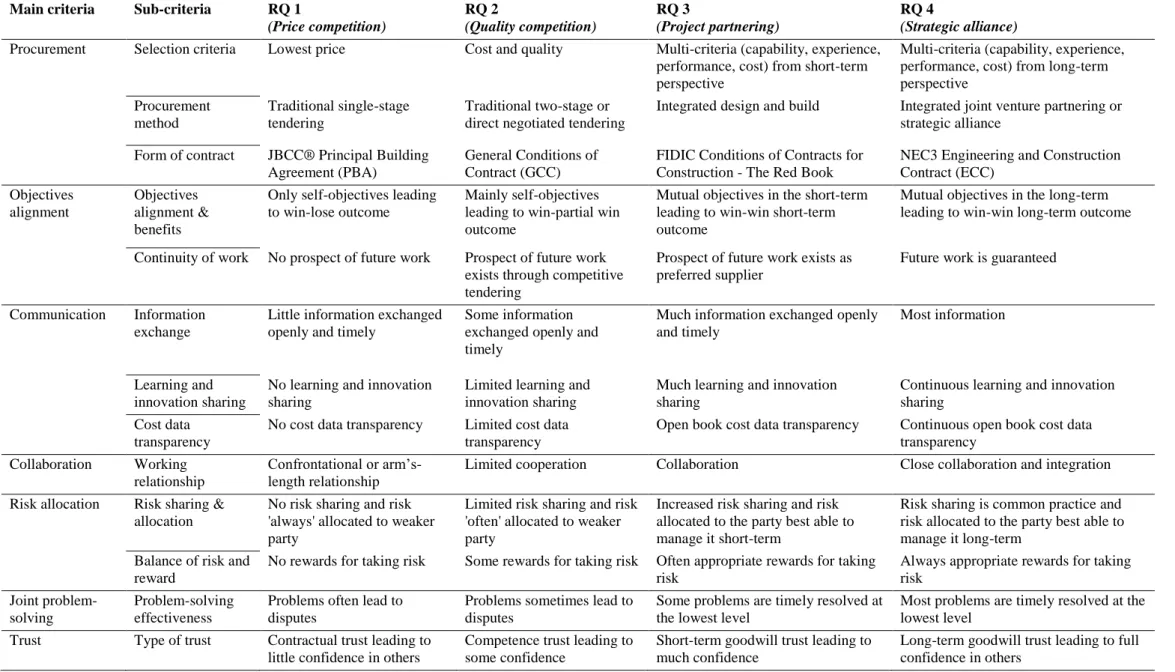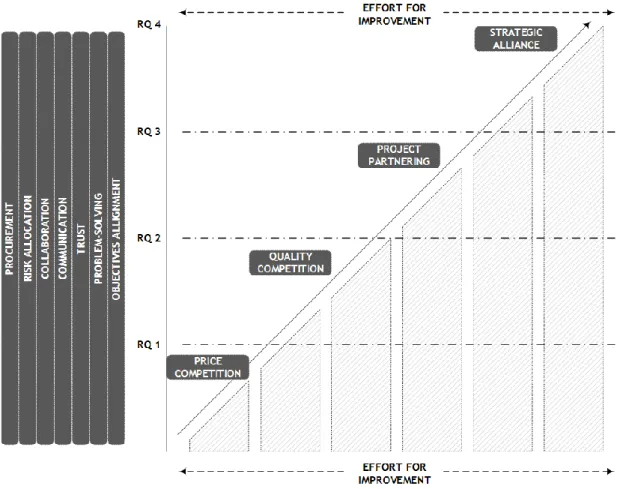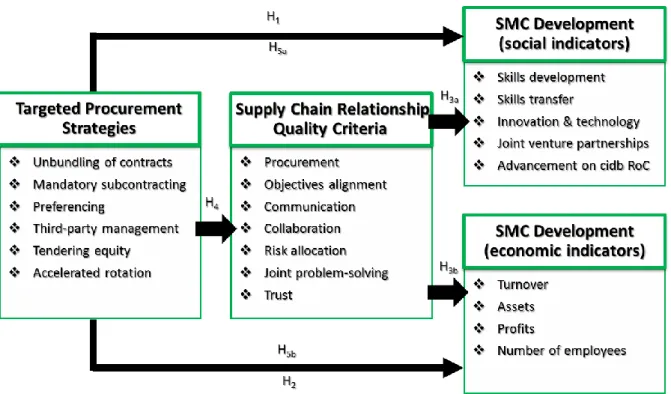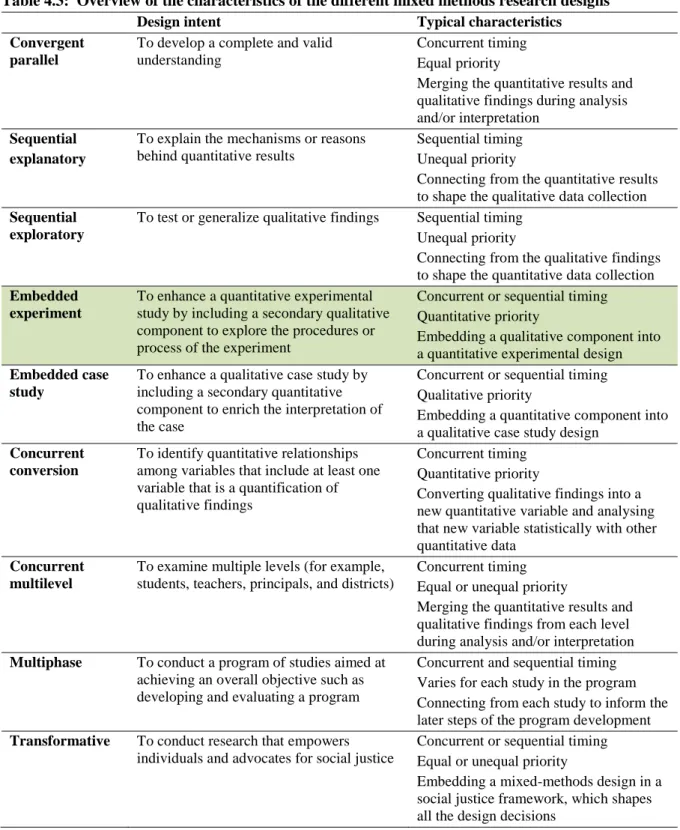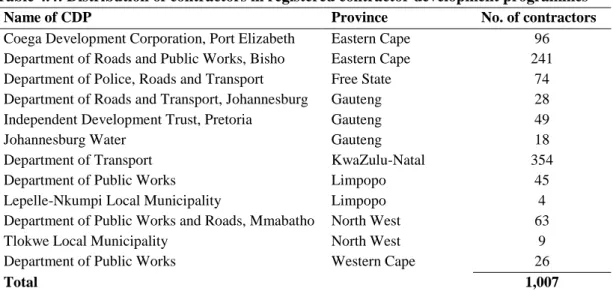In addition, the quality of relationships was found to be an important mediator in the relationship between targeted procurement strategies and contractor development. Adediran and Windapo (2016a) is a concept paper that links the research constructs and presents a conceptual framework for the PhD research, proposing a direct relationship between targeted procurement strategies (independent variable), relationship quality (intermediate variable), and SMC development ( dependent variable), as well as an indirect relationship between targeted procurement strategies and SMC development.
LIST OF ABBREVIATIONS AND ACRONYMS
CHAPTER ONE: GENERAL INTRODUCTION
INTRODUCTION
BACKGROUND TO THE RESEARCH
Relationship quality provides an indication of the strength and effectiveness of relationships in project management (Jelodar et al. 2016). Jelodar et al. 2016) asserted that relationship quality and its attributes can be developed and improved.
STATEMENT OF THE PROBLEM
However, the effects of government intervention and support on the performance of individual firms have yet to be fully explored, and attempts to measure the impact of targeted public procurement on the growth and development of individual SMCs in South Africa remain inconclusive. This creates an opportunity for further studies to fill the knowledge gap and provide objective empirical evidence on the relationship between targeted procurement strategies and SMC development and whether appropriate relationship quality mediates this relationship.
RESEARCH QUESTIONS
AIM AND OBJECTIVES OF THE RESEARCH
Establish the links between targeted procurement strategies, SMC development, and the quality of relationships between SMCs and other parties in the project supply chain. Investigate whether targeted procurement strategies affect SMC development and the quality of relationships between SMCs and other parties in the project supply chain.
JUSTIFICATION FOR THE STUDY
Identify the targeted procurement strategies commonly used as a mechanism for contractor development and assess the quality of supply chain relationships between SMCs and other project parties in the targeted procurement process. Determine the indirect effect of targeted sourcing strategies on SMC development, through supply chain relationship quality as a mediator.
OVERVIEW OF RESEARCH METHODOLOGY
The study appears to provide a better understanding of the role of preferential procurement arrangements and relationship quality in stimulating the growth performance and development of SMCs in the construction industry in South Africa over the period 2011 to 2015. Further details of the research methodology and methods are presented in chapter four of the thesis.
SCOPE OF THE STUDY
For the focus group interview, seven of the twelve contractors invited participated in an interview conducted on 28 November 2016 at the state-owned entity's offices in Port Elizabeth, Eastern Cape, South Africa. Principal component analysis was also used to reduce and further classify research construct variables for model development.
THESIS STRUCTURE
Chapter Seven presents the interpretation and discussion of empirical results and findings in relation to existing literature. Chapter Eight presents the overall summary of research findings of the thesis, and shows the extent to which the research objectives have been achieved.
CHAPTER TWO: LITERATURE REVIEW
INTRODUCTION
CONCEPTUALIZING (PUBLIC) PROCUREMENT
Public procurement is also an important instrument for achieving socio-economic goals (McCrudden, 2004; Arrowsmith, 1995), providing opportunities for government to implement selected national policies (Thai, 2001). Government procurement has two broad objectives – primary procurement objectives and secondary non-procurement objectives (Thai, 2001; McCrudden, 1995; Arrowsmith, 1995; United Nations Commission for International Trade Law [UNCITRAL], 1995).
PUBLIC PROCUREMENT AS AN INSTRUMENT OF SOCIAL POLICY
In many countries such as the Netherlands and Belgium, the use of procurement as a tool to address unemployment continues (Hessel et al., 2000; McCrudden, 2004). McCrudden (2004) highlighted three relatively distinct models of the procurement-social development nexus, namely: the use of procurement as a method of enforcing anti-discrimination law in the employment context; using procurement to advance a broader concept of distributive justice for example, affirmative action in employment; and the use of 'preferential' procurement as a method to help stimulate increased entrepreneurial activity by disadvantaged groups, for example 'set aside' minority or historically disadvantaged businesses.
ROLE OF THE CONSTRUCTION INDUSTRY IN SOCIO-ECONOMIC DEVELOPMENT
- Promoting social opportunities in the procurement of construction projects Investment in infrastructure contributes to not only economic growth but also human
- Public procurement and SME (contractor) development goals
Later studies challenged Torino, Wells and the World Bank's claims about the state of the construction industry. Some authors focus on the issue of job creation (1994); others emphasize the multiplier effect on other sectors of the economy (Bon, 1991), for example the SME sector (as cited in Lopes, 2012).
OVERVIEW OF PREFERENTIAL PROCUREMENT POLICIES
Sales to government were considered important in the US, particularly for small businesses (Bates, 1997), as the extent of preferential procurement programs was substantial with more than 10% of minority-owned firms reporting doing business with government clients ( Bates and Williams, 1995). Blanchflower and Wainwright (2005) also found that the removal of layoffs resulted in 80 to 99% reductions in minority business participation in public procurement in the construction industry.
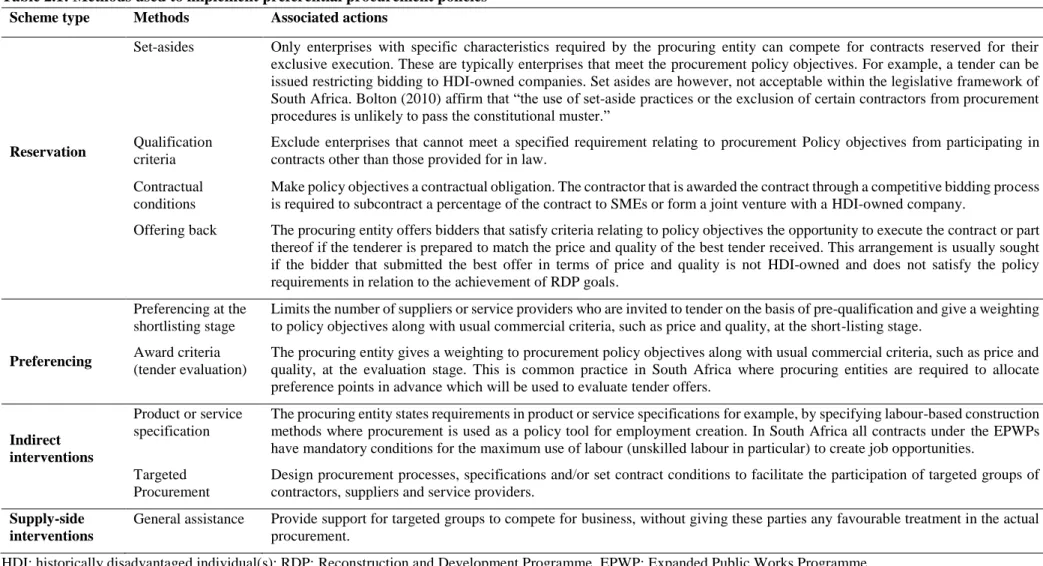
PREFERENTIAL PROCUREMENT AND CONTRACTOR DEVELOPMENT IN SOUTH AFRICA
- Preferential procurement as a constitutional and legislative framework
- Preferential Procurement Policy Framework Act
- Preferential targeted procurement in the South African construction industry Preferential procurement policies in the South African construction industry are currently being
- Contractor development initiatives in South Africa
In the South African construction industry, supply-side interventions have recently been implemented through contractor development programmes. Following the launch of the ECDP, cidb, in partnership with national and provincial public works departments and related stakeholders, also launched the National Contractor Development Program (NCDP) framework to: address some of the constraints to growth among previously disadvantaged contractors; develop sustainable contracting capabilities in the construction industry; and promote capital ownership in different levels and categories of cidb (Adediran and Windapo, 2016a; DPW and cidb, 2011).
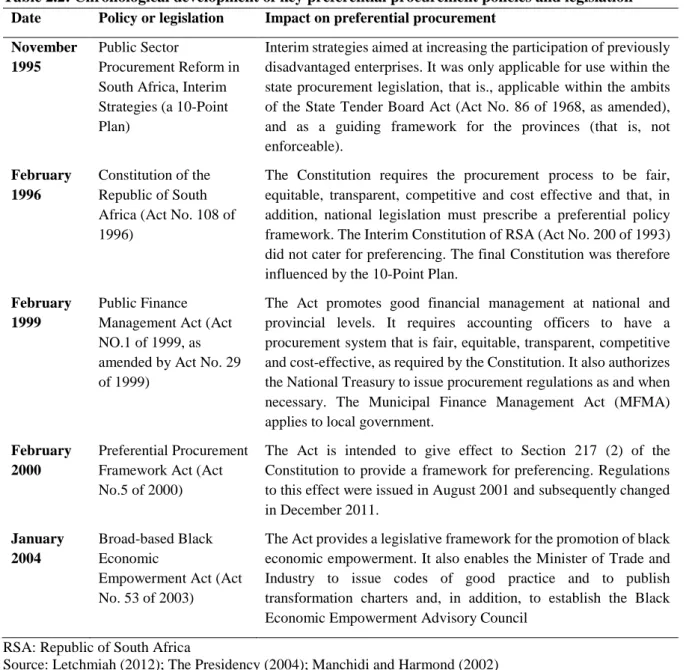
SUPPLY CHAIN RELATIONSHIP QUALITY IN THE CONSTRUCTION INDUSTRY
The use of project procurement and contracting methods that promote collaborative relationships for construction industry development is well documented in the literature (Cox and Thompson, 1997; Jelodar et al., 2016). Project networks have also been shown to facilitate organizational learning (Barringer and Harrison 2000), enable effective knowledge transfer (Uzzi, 1997) and increase firm performance (Matinheikki et al. 2016).
OVERVIEW OF SUPPLY CHAIN RELATIONSHIP MODELS
Hine, Larson and Meng et al. 's model establishes two levels each for traditional relationships and collaborative relationships. Meng et al. 's model is a robust systematic model that examines the specific characteristics of the construction industry project network, for example the existence of different types of relationships at different levels of the project supply chain.

RELATIONSHIP QUALITY ASSESSMENT CRITERIA
- Procurement
- Objectives alignment
- Communication
- Collaboration
- Risk allocation
- Joint problem-solving
- Trust
Successful supply chain collaboration is ensured by shared objectives and mutual benefits (Meng et al., 2011). Collaboration reflects whether project supply chain parties work cooperatively together and how closely the parties work together (Meng et al., 2011).
MEASURES OF SMC GROWTH AND DEVELOPMENT
- Approach to growth and development measures
- Social indicators of SMC development
Assets consist of non-current assets (assets that are relatively permanent, in that they are not held for sale or conversion to cash, but are held as a production tool, or to generate income, e.g. land, buildings and machines) and current assets (assets created or acquired for sale and conversion to cash, or assets in the form of cash or money at the bank) (Calvert et al., 2003). Innovation can be divided into two categories, namely: administrative (the impact of an organization's social systems) and technical (improvement of an organization's technical capabilities) (Damanpour et al., 1989).
SUMMARY OF LITERATURE REVIEW
In the context of this study, joint venture partnerships as a measure of QMS development are consistent with the third rationale where public sector clients provide bidding preferences to large contractors that have entered into JV partnerships with small contractors in awarding contracts. of the targeted procurement. However, joint venture success reports vary widely; although the trend is toward a better-than-expected experience, both in terms of profitability and marketability (Sillars also cautioned that partnerships with high-end companies can be a double-edged sword.
CHAPTER THREE
THEORETICAL AND CONCEPTUAL FRAMEWORK OF THE STUDY
- INTRODUCTION
- OVERVIEW OF THE RESEARCH CONTEXT
- THEORETICAL PERSPECTIVES OF THE STUDY
- Theory of the growth of the firm
- Industrial organisation economics
- The Chicago School of Thought
- Structure-conduct-performance (SCP) framework
- New industrial economics
- Relational governance theory
- HYPOTHESIS DEVELOPMENT
- Relationship between government intervention through preferential procurement and firm growth performance and development
- Relationship quality and firm growth performance and development
- Nexus between procurement, supply chain relationships and firm growth performance and development
- SUMMARY OF THEORETICAL PERSPECTIVES
- CHAPTER FOUR
Market structure here refers to the characteristics of the industry that influence the relationship between firms in the industry (Terry and Forde, 1992). The purchasing relationship is an entity that can provide information that describes structural and behavioral characteristics of the industrial organization of the construction industry through the supply chain concept.
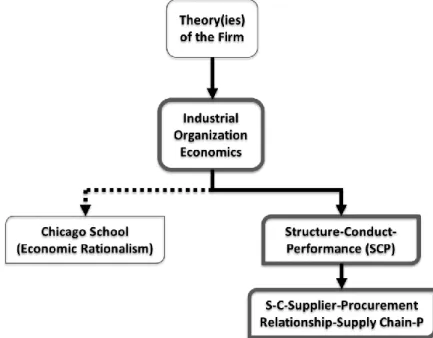
RESEARCH DESIGN AND METHODOLOGY
INTRODUCTION
RESEARCH PHILOSOPHY
The general terms used to describe the set of assumptions in social science research include “paradigm” and “worldview” (see Creswell and Plano Clark, 2011 for discussion). This study uses "research paradigm" to describe research assumptions made, which are based on the knowledge of the research problem (Lincoln et al., 2011).
THE RESEARCH PARADIGM
- The epistemological approach
- The ontological approach
- Pragmatism
Greener (2011) proposed that ontology is considered when a researcher thinks that the guiding theory about an investigation exists independently of the researcher's perception. Pragmatist assumptions are based on knowledge or experience and inquiry, which is widely accepted as the basis of the mixed methods approach to research (Onwuegbuzie and Johnson, 2006).
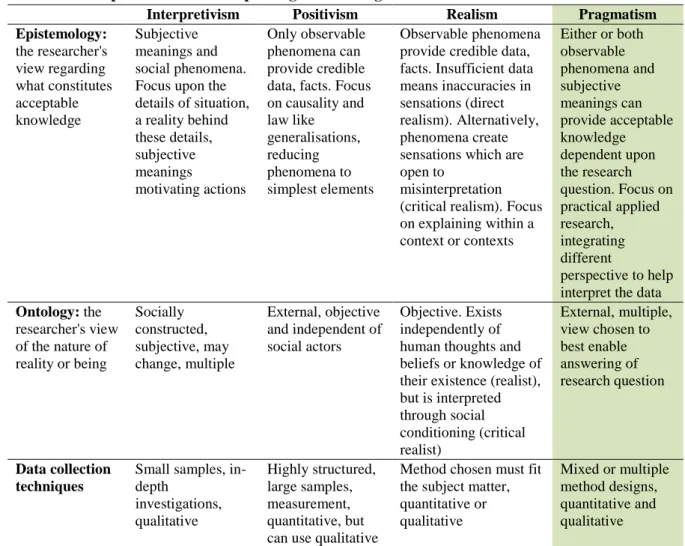
RESEARCH APPROACH
- Quantitative research
- The qualitative research approach
- The mixed methods research approach
Amaratunga, et al., (2002) explains that qualitative researchers investigate beliefs, understandings, opinions and views. According to Plano Clark and Creswell (2015), mixed methods research designs differ in terms of their priority, which refers to the relative importance of the quantitative and qualitative components in addressing the purpose of the study.
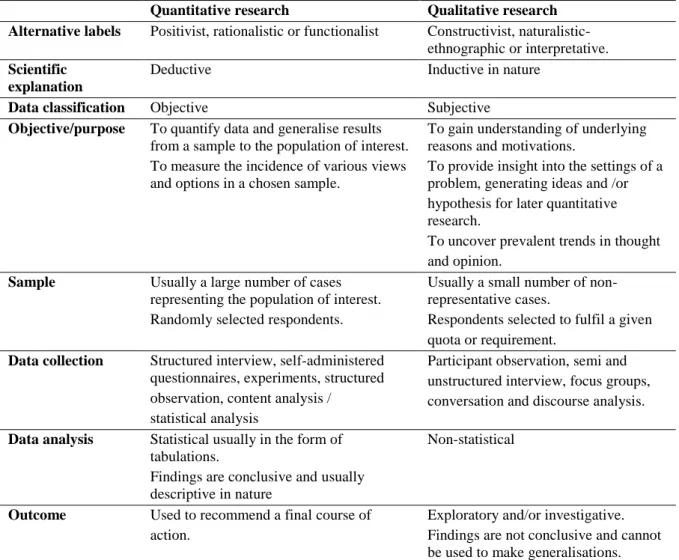
RESEARCH APPROACH FOR THIS STUDY
- Embedded mixed methods research design
Embedding or including qualitative data paved the way for the exploration of the relationship quality attribute of the study. Thus, the results of the secondary qualitative component, while less of a priority for the overall purpose of the study, served to provide an additional source of information for the primary quantitative component.
STUDY POPULATION, SAMPLING TECHNIQUE AND SAMPLE SIZE .1 Study population
- Sampling technique
- Sample size
Nevertheless, it was still necessary to determine the appropriate sample size that would be representative of the study population. The revised sample size for the study was estimated at 88 participants from the study population (Equation 4.4).
UNIT OF ANALYSIS
INSTRUMENTS OF DATA COLLECTION
- Questionnaire development
- Semi-structured interview
The questionnaire was divided into five parts, preceded by a preliminary part, which required the consent of the respondents to participate in the study. This section provides further details on the research constructs and variables used in the questionnaire.
CRITERIA FOR JUDGING THE QUALITY OF THE RESEARCH DESIGN A fundamental part of a research process is the ability of the researcher to judge the quality of
- Internal validity
- External validity
- Reliability
The study benefited from the use of focus group interviewing because the interaction between the interviewees provided useful information. Content validity refers to the extent to which questionnaire items are representative of all aspects of the constructs being measured.
METHODS OF DATA ANALYSIS
- Mean scores
- Principal components analysis (PCA)
- Spearman rank-order correlation
- Multinomial regression
- Partial least squares structural equation modelling (PLS-SEM)
However, principal component analysis was further used to determine the dimensionality of the scales, and presented in Chapter Five. Principal component analysis (PCA) was also used to reduce and further classify variables of the research constructs for model development.
ETHICAL CONSIDERATIONS
The use of PLS-SEM was further prompted by the dated but still relevant admonition “the subject of organizational growth has advanced beyond the abyssal darkness. Although the hypotheses tested were initially tested quantitatively in Chapter Five, the use of PLS-SEM proved to be a useful and more robust technique for this empirical and theoretical research as its applications in construction research continued to increase (Xiong et al. 2015) ), especially for forecasting purposes (Oyewobi, 2014).
SUMMARY OF DISCUSSIONS ON RESEARCH METHODOLOGY
The predictive power of the PLS-SEM model will be assessed by R2 values with a recommended lower limit of 10% (Elbanna et al., 2013; Henseler et al., 2014), which is good enough. R2 to influence organizational performance over time (for a discussion, see Jacobson, 1987). In addition, the PLS-SEM technique was used to validate the conceptual model developed in Chapter Three.
CHAPTER FIVE
DATA PRESENTATION, ANALYSIS AND RESULTS
INTRODUCTION
GENERAL PROFILE OF STUDY PARTICIPANTS
- General profile of the SMCs and responding officers surveyed
The majority of technical (90%) and professional (95%) staff have at least Grade 12 certificates; while 48 (16%) and 116 (38%) technical and professional employees respectively have a university education.
SMCS’ PARTICIPATION IN TARGETED PROCUREMENT CONTRACTS AND CONTRACTOR DEVELOPMENT PROGRAMMES
While 156 (51%) have not executed any non-targeted government procurement contracts and private sector contracts, respectively, during the observation period. Furthermore, 7 (7%) and 34 (36%) SMCs have experienced a negative and positive progression in cidb RoC, respectively, while 53 (57%) have maintained their cidb classification since participating in a CDP.
ASSESSMENT OF RESEARCH CONSTRUCTS
- Targeted Procurement strategies
- Supply chain relationship quality .1 Descriptive statistics
- SMC growth performance and development
Research objectives One of the studies also sought to determine the quality of supply chain relationships between SMCs and other project parties in the targeted procurement process. Therefore, respondents were asked to indicate the quality of the supply chain relationship experienced in the targeted procurement process using four-point Likert scale questions from 1 (arm's length adversarial) to 4 (close long-term cooperation).

IDENTIFYING THE UNDERLYING DIMENSIONS OF THE RESEARCH VARIABLES
- Test of sample adequacy and appropriateness
- Principal component analysis
- Summary of statistics of the research variables
PCA revealed that only one component had eigenvalues greater than one, explaining 39% of the total variance. Initial PCA results show that three components had eigenvalues greater than one, cumulatively explaining 70% of the total variance (see Table 5.11).

TESTING OF RESEARCH HYPOTHESES
- Correlation analysis of the research variables
- Targeted Procurement strategies and SMC growth performance and development
- Targeted Procurement strategies and relationship quality
- Supply chain relationship quality and SMC development
- Mediated indirect effects of Targeted Procurement strategies on SMC development through relationship quality
Hypothesis 5a: Supply chain relationship quality mediates the relationship between goal-oriented procurement strategies and social indicators of SMC construction development. Hypothesis 5a states that: Relationship quality mediates the relationship between goal-oriented procurement strategies and social indicators of SMC construction development.
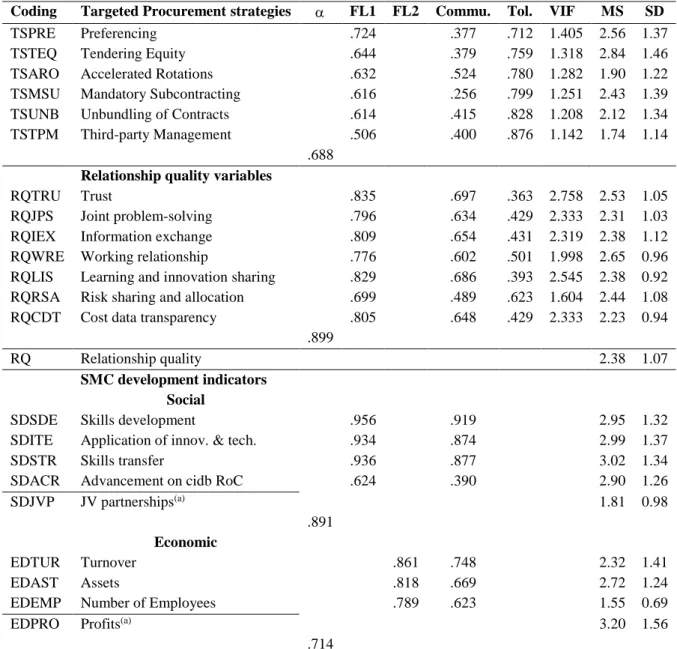
SUMMARY OF DATA PRESTATION AND ANALYSIS
In addition, approximately 12% of the variance in firm profits was accounted for by mandatory subcontracting and relationship quality (R2 = 0.118). It should also be noted that other statistics (such as the p-value) demonstrated the validity of the models.

CHAPTER SIX
VALIDATION OF CONCEPTUAL MODEL
- INTRODUCTION
- MODEL DEVELOPMENT
- MODEL ANALYSIS AND FITTING USING PLS-SEM
- Model validation: assessment of measurement (outer) model
- Model validation: assessment of structural (inner) model
- Model validation: development of structural equations
- Model evaluation: analysis of global fit measures (GoF)
- SUMMARY OF CONCEPTUAL MODEL VALIDATION
- CHAPTER SEVEN
H5a: Quality in supply chain relationships mediates the relationship between targeted procurement strategies and social indicators of construction SMC development. H5b: Quality in the supply chain relationship mediates the relationship between targeted procurement strategies and financial indicators of construction SMC development.

DISCUSSION OF RESULTS AND FINDINGS
- INTRODUCTION
- BACKGROUND PROFILE OF THE SMCS AND RESPONDENTS
- SMCS’ PARTICIPATION IN TARGETED PROCUREMENT CONTRACTS AND CDPS
- TARGETED PROCUREMENT STRATEGIES COMMONLY USED AS A MECHANISM FOR CONTRACTOR DEVELOPMENT
- SUPPLY CHAIN RELATIONSHIP QUALITY IN THE TARGETED PROCUREMENT PROCESS
The results obtained showed that the most commonly used targeted procurement strategy as a contractor development mechanism was equity procurement; This is followed by preference, mandatory subcontracting and unbundling of contracts. The result of the assessment of relationship quality criteria showed that trust between SMCs and other project parties in the targeted procurement process was relatively low, with the majority reporting that trust was based on competence rather than goodwill.
